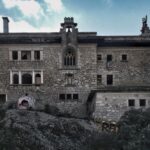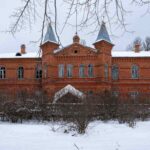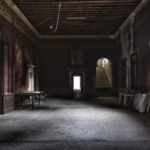The Orthodox Church in Galgauska: from its noble construction in the 19th century to the struggle for its preservation, an investigation into the history and symbolic significance of this abandoned building in the heart of Galgauska County.


History of the Galgauska Orthodox Church
The popular name of the ‘Galgauska Orthodox Church’ comes from the place where it is located, Galgauska County. In the 16th-17th century, in the area where the church would later be built, there was an estate named after its first owner, a Pole by the name of Golgovski (the name Galgauska was later derived from his surname). In 1631, the Golgovski estate became the property of the Budberg Barons, and in 1656 it passed into the hands of the Mengden family.


Construction and History of the Church of St John the Baptist
The Church of St John the Baptist was built between 1850 and 1860 by the Mengden family, and the same family remained in the manor until the First World War. The manor house was demolished around 1920, but the church of St John the Baptist managed to survive. In 1918, the parish had 627 people.

Desecration and Deterioration: The Struggle for Preservation
Since the 1980s, however, the religious building has been abandoned, looted and desecrated. The floorboards were dismantled and the place where the altar stood was defaced. Before it was vandalised, inside the church there was a huge candelabra with 320 candles, at least seven bells, a large iconostasis with icons and two ornate fireplaces. The smallest of the bells is still preserved in the Galgauska chapel. The interior of the church was decorated with wall paintings, as well as covering the ceiling. Of these, one can still make out the stars on the ceiling and the silhouette of an angel sitting on a cloud above the entrance door.



An Abandoned Place of Devotion: Description of the Present State
Today, time has carved a deep gash in the walls of the noble building and it has become dangerous to visit. Near the church is also the cemetery of Baron Mendengai. The gravestones are still well preserved, but the cemetery itself, unprotected and unguarded, has been repeatedly desecrated. Several years ago, the ground around the church was cleared of weeds and trees and the interior was cleared of debris. The faithful left icons, Bibles and candles to commemorate the symbolic significance of this church for the Galgauska community. Despite the efforts of residents, the building still lies in ruins, with the ceiling and floor partially collapsed.



Exploring the church and the woods
It is a strange feeling when amid wild woods and mown meadows one suddenly finds this abandoned building with its door wide open. Today the weather was kind and the sun shone like a hundred candles. As one climbs the steps, elegantly framed by groves of birch, celandine and other trees, wariness is replaced by admiration. One wants to enter quietly as if one might disturb someone.
The ruined church illustrates the state of the soul of a man who has abandoned God. Empty, unkempt, wounded, but the temple has not completely lost its glory, just as man, fallen into sin, does not lose the image of God within him. This must be remembered. It must be restored.
For you are the house of the living God, as God has said, ‘I will dwell in them and walk among them; I will be their God and they shall be my people.’ (2 Corinthians 6:16)



Urbex location:




